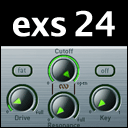
Making Multi-Sampled EXS24 Instruments
May 8th 2013
In this tutorial from dancemidisamples.com we’re going to talk you through creating a multi sampled EXS24 instrument in Apple Logic.
A multi sampled instrument by definition is a sampler instrument that uses more than one sample to create a more natural feel when notes are stretched up and down a key-range. So rather than just taking a single note and stretching it up and down an entire key-range we going to use several or more samples to create a more natural feel to our final sampled instrument.
One of the main uses for multi-sampling is to capture the sound of a hardware synth in a playable format – so today we’re going to create a multi-sample from the Access Virus Powercore and turn that into a playable EXS24 instrument in Logic.
We’re going to start to create our multi-sampled instrument by sampling some notes from the key range of our chosen preset.
We’re going to use the keys C and G in every octave for the basis of our multi-sample, this works well for simple synth sounds, but it’s also possible to make this as complex as you like. Some sample libraries for ‘real’ instruments such as concert pianos and stringed instruments may sample every single note in an entire key-range at different velocities building up complex layers for a natural sounding instrument, however for a simple synth this isn’t necessary.
At this stage before we sample our key range its a good idea to mute any effects on your instrument and any send effects in Logic too as these are going to be best added to your finished instrument later on while you’re creating a composition.
You might also find it useful to change the amplitude envelope settings on your target instrument to low settings – as again these are controls that you’ll probably like to be able to adjust in you’re finished instrument. I usually set attack and release to very near zero in my target instrument and then add these in my final sampled instrument.
Once you’ve created this region featuring C and G notes up an entire key range the next step is to take a bounce (if you’re a Logic user), or render of the audio region.
Once that file has been created the next step is to extract each single note from the file. My preferred method for slicing these files out is Propellerhead’s Recycle! as it’s very fast at tasks like this. However, you can use pretty much any audio editor out there for this task.
At this point it’s a good idea to create a new folder for your instrument to contain the samples we’re about to export.
Once we’ve exported each slice, we need to tell the EXS24 how to map out these samples up the key-range, and the way we do this is by naming each sample with it’s key note.
And as you’ll see in the video, name each corresponding slice with it’s key note, so slice 1 becomes C1, slice 2 becomes G1, slice 3 becomes C2, slice 4 becomes G2 etc up the entire range.
Once you’ve done that you can import the samples into the EXS24.
Back in Logic create a blank instance of the EXS24 and press the edit button, from the menu choose ‘zone’ and ‘load multi samples’.
This will bring up a load dialogue box, so navigate to where you’ve exported your sample slices and press ‘add all’ and then ‘done’ on the bottom right.
This will bring up a dialogue box with three options, we’ll choose auto map – which will read the key note from each of our named slices.
Press OK and you can see that the EXS has loaded each of our samples and assigned each to it’s correct key range. you can see each region along the bottom here.
All you need to do now is press ‘close’ from the top left of the sample edit screen, and name the instrument.
We need to turn this into a useful playable instrument so I’m going to mess with the amplitude envelope settings, adding a little release and as this was a plucked sound we’ll add some decay to the filter envelope. In this case I’m assigning filter cut-off to envelope 1, so when we reduce the filter cutoff it creates a more classic Trance pluck sound.
Turn the send FX back on in Logic and play the original riff – it should sound pretty close to the original patch!
It’s now possible to export the EXS24 preset for use in other formats – Ableton Live’s ‘Sampler’ will import EXS instruments directly as can NI ‘Kontakt’. you can also use Chicken Systems ‘Translator’ to convert the instrument to pretty much any other sampler format too including hardware samplers.
{{widget type=”flexiblewidget/list” column_count=”6″ limit_count=”5″ header=”New product” if=”#” order_by=”name asc” template=”flexiblewidget/list.phtml” category=”105″}}